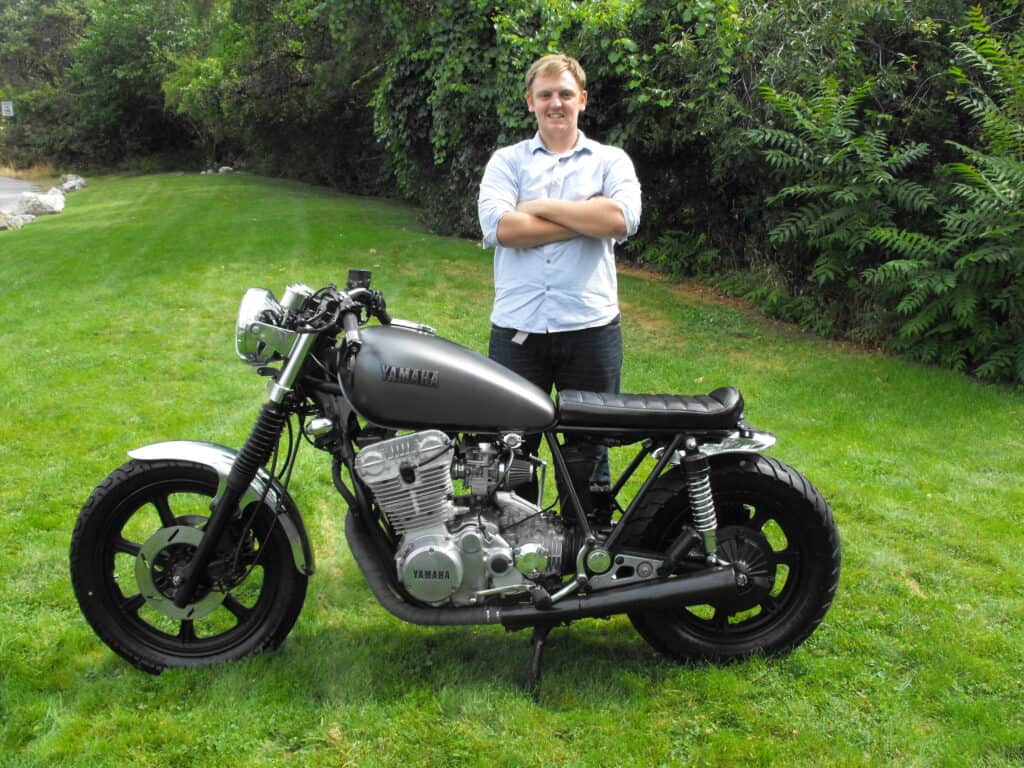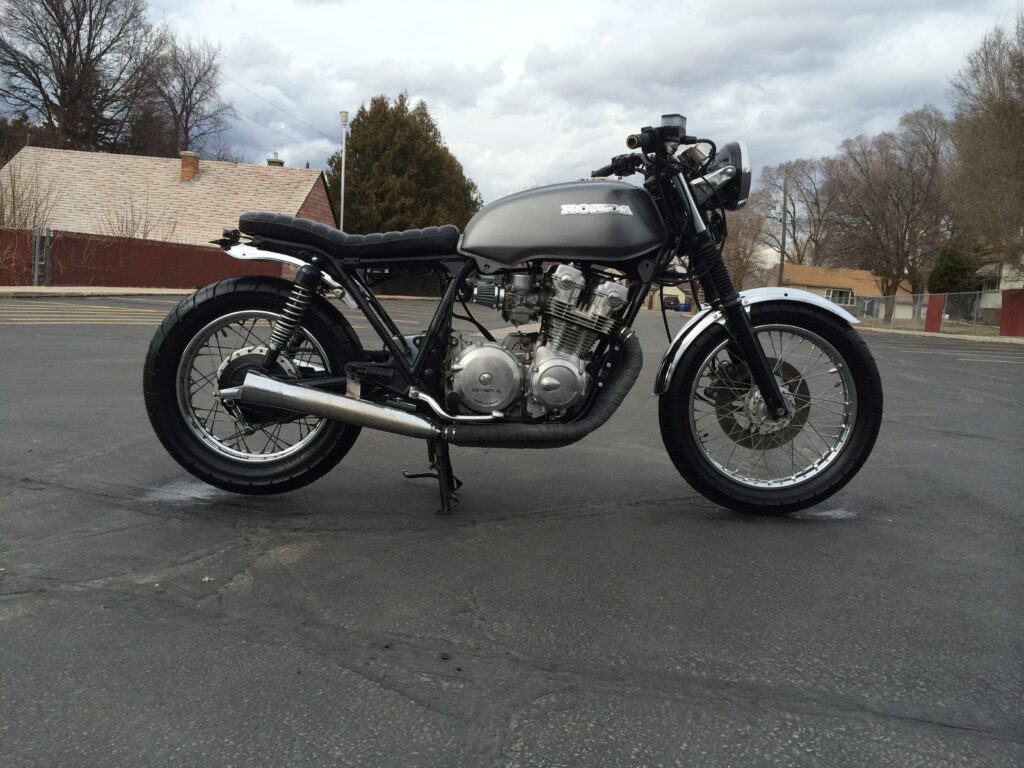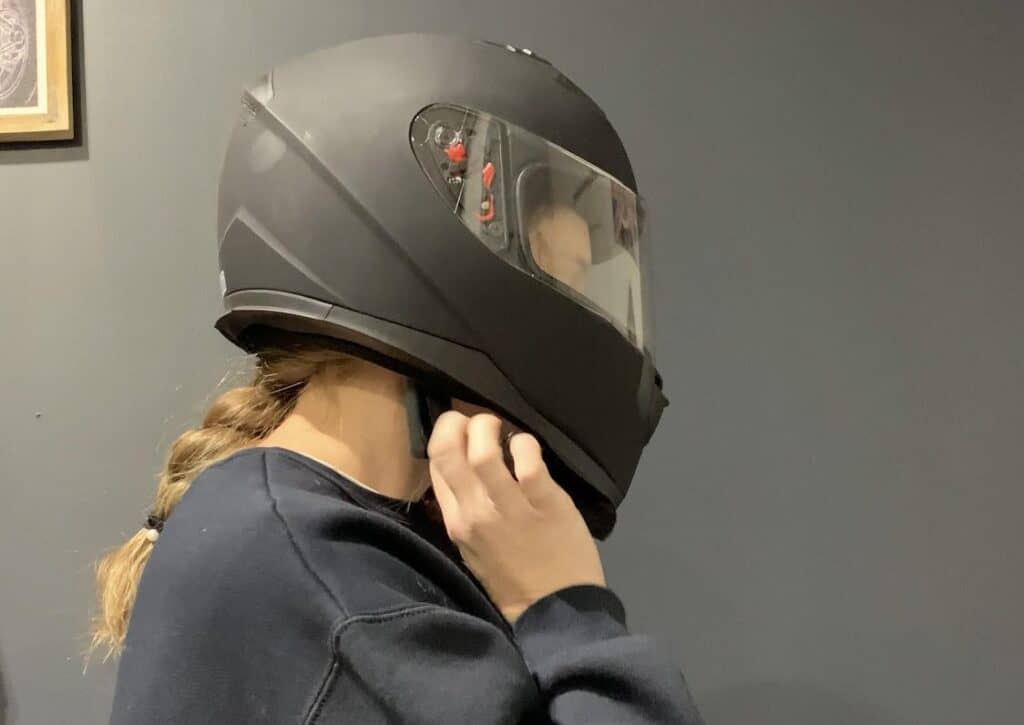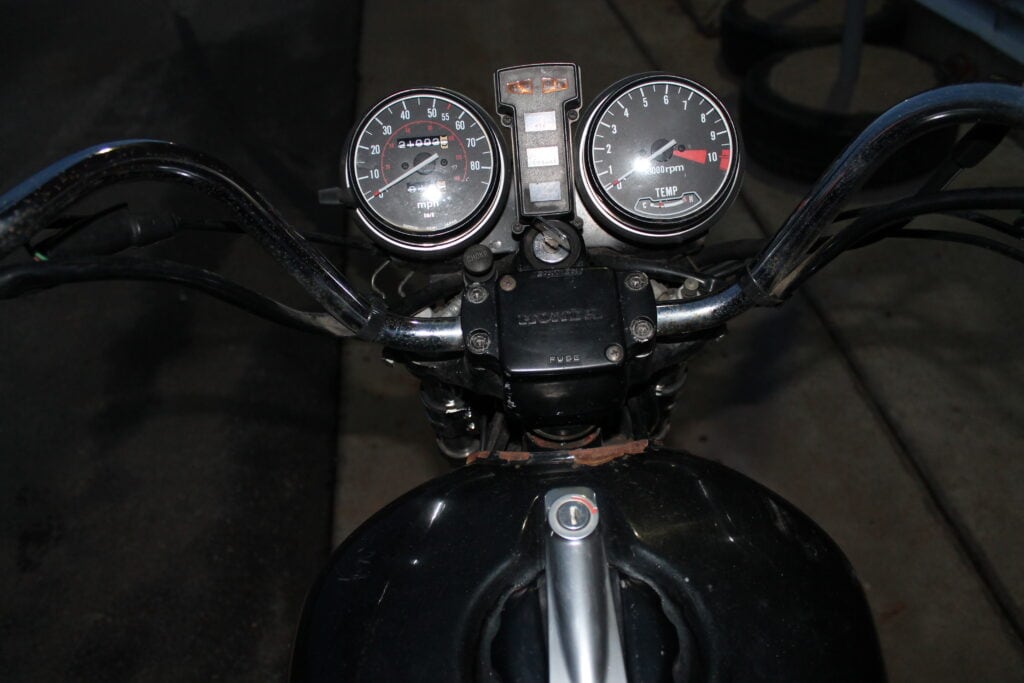
The beginning process of learning how to ride a motorcycle is an exciting yet nerve racking time. It’s completely different from driving a car so it’s as if you’re learning how to drive all over again.
Luckily, it’s a skill that can be quickly learned if you’re willing to put in the practice. I didn’t start learning how to ride a motorcycle until I was in college. These are helpful tips I wish someone would have told me when I was beginning to ride motorcycles that will be helpful for you.
Start Out With An Old Motorcycle
Learning how to properly operate a motorcycle takes a lot of practice. And through that practice, you may have found yourself damaging the motorcycle just a little bit either from taking a turn too sharply or simply dropping the motorcycle altogether.
Don’t get frustrated when this happens; it’s fairly common and a lot of motorcycle owners do it. But for this very reason it’s best to first start out with an older, less expensive motorcycle. Don’t go out and buy the motorcycle of your dreams to practice on because chances are you’ll scratch it up in some way.
I first learned how to ride a motorcycle on a 1980 Yamaha XS850. It was old, worn out, and perfect for me to learn how to ride. I wasn’t worried the whole time about whether or not I was going to damage it because I didn’t really care if I did.
Shop For Good Insurance
Before you even think about getting on a motorcycle and start riding it, you will need to obtain motorcycle insurance. Insurance is usually only given when you have at least a permit to operate a motorcycle, so be sure to get your permit so you’re covered while you’re out on the road.
In addition, don’t just go with the first insurance quote that you get. Shop around a little bit to get the best deal out there. You’d be surprised at how big of a difference there is in premiums between insurance companies. Motorcycle insurance quotes are easy to get and it shouldn’t take you long to get several of them so you can decide which is best for you. In fact, you can click here to view our page of motorcycle insurance options and compare rates specific to you.
Get As Much Insurance Coverage As Possible
The type of insurance that most states require motorcyclists to get is liability insurance. This means that if you cause an accident on your motorcycle, your insurance will cover damages for the other party. That can be incredibly helpful, but there can also be a lot more involved in a motorcycle accident than just covering bills for someone else.
Your motorcycle liability insurance does not cover any damages on your bike or your medical bills. And if you get the minimum liability, that’s not a guarantee that it’ll cover all the other party’s damages either if the accident was serious enough.
Before committing to insurance, consider getting additional add-ons to it such as comprehensive or uninsured/underinsured. Accidents can get expensive very quickly (which I found out the hard way from my own accident). Do some research about what type of insurance is best for you. You could be the best rider around, even as a beginner rider, but that doesn’t mean the other drivers around you are as good.
Practice In Empty Parking Lots

The very best place to learn how to ride a motorcycle is in a large, empty parking lot. Ideal spots may include school and church parking lots after hours so you don’t have to worry about many cars coming in and out.
Parking lots are great because they already have lines you can practice riding around and you don’t have to worry about other drivers stressing you out. It’s basically a no-judgement zone.
Practice In Wet Empty Parking Lots
Along with practicing your riding skills as a beginner in empty parking lots, it’s also a good idea to practice riding in empty parking lots that are wet after a big rain storm.
If you plan on riding a motorcycle, chances are you’ll get caught in a rain storm which leaves you riding on wet roads. Wet roads on a motorcycle are much different than riding on dry roads and it can be dangerous for the rider if they don’t know how to do it.
Practicing your riding skills in wet conditions in a controlled environment, such as a wet parking lot, will help you get a better idea of what it’s like riding when it’s slippery. This will help you become a much better defensive rider and keep you prepared for when those rainstorms come.
Practice Hard Maneuvering
One of the most intimidating parts about learning how to ride a motorcycle is gaining the skill of maneuvering the motorcycle correctly. It may seem simple when you see other motorcyclists do it; all you have to do is turn the handle bars and you’ll be good, right?
It’s actually much more difficult than that. And you may be caught in some situations that require hard maneuvering and sudden movements. During your practice as a beginner, make sure you practice sharp turns and tight circles. In addition to that, you should also practice quick acceleration as well as hard braking because there’ll be a time when you’ll really need to do that in the real world.
Low Speed Practice
Balancing becomes much more difficult when you’re going very slow on a motorcycle. It’s the same principle to riding a bike; the momentum of the motorcycle helps you keep your balance. That’s why it’s important you practice going very low speeds because you will be doing that a lot out on the road.
Also try practicing going low speeds without taking your feet off the foot pegs and see how slow you can go without doing so. This will help you understand your limits and capabilities.
Incline Practice
A lot of motorcycles have a manual transmission which means you have to change gears yourself. While this usually isn’t a problem for most riders, riding up a hill can be a bit difficult for almost every rider with a manual transmission.
Riding on an incline is always a good practice method for beginner riders. It’s incredibly frustrating missing a gear while riding up a hill and the motorcycle ends up dying in the process. You can try first getting a head start and riding up hills and eventually try riding up a hill starting at the bottom (meaning you start at an incline without a head start).
Start out with small inclines and gradually work your way up to steeper hills. This will help you be prepared to ride almost anywhere on the roads.
Get Basic Tools For Maintenance

Owning a motorcycle means you’ll have to keep up with the maintenance so it continues to work. Whether you have an old or new motorcycle, having tools handy to do some quick fixes is going to make your day easier.
Some basic tools I recommend is a socket/ratchet and wrench set both in Metric and English units as well as wire strippers, channel lock pliers, and a motorcycle lift. Click here to see the specific tools I suggest in my list of recommended tools.
Learn To Fix Things Yourself
Having the right basic tools during motorcycle ownership is a great way to help you learn how to do basic fixes on your motorcycle. As a beginning rider, you may be intimidated to make some necessary fixes on your bike, but there’s actually a lot of maintenance and repairs you can learn to do yourself if you’re willing to learn.
After I learned how to ride a motorcycle, I started buying more of them, fixed them up, and sold them for a profit to help pay for my college education. I quickly learned that online forums and YouTube were excellent resources in helping me learn how to do repairs on the specific type of motorcycle I had.
You’re going to have repairs and fixes needed on any type of motorcycle you own. You might as well save a little bit of money while learning a new skill and try to make those repairs and maintain it yourself. See my article here to learn more about how often a motorcycle needs to be serviced.
Take A Riding Safety Course
A riding safety course, also referred to as just a motorcycle safety course, is a class that lasts 1-3 days. It consists of several hours of in-classroom work as well as several hours of actually practicing riding a motorcycle with help from an instructor.
Most are able to find this course offered within 100 miles of where they live and cost ranges between $250-$300, depending on the instructor. Some states will even allow the passing of this class to count as your driving test to get your motorcycle license.
The Motorcycle Safety Foundation reported that the accident rate of untrained riders (meaning those who did not take a riding safety course) is more than double the accident rates of their trained counterparts. With numbers like that, I wouldn’t want to risk not taking this course.
Some insurance companies will give discounts to those who complete a motorcycle safety riding course.
Wait For Expensive Upgrades
As I had mentioned before, I learned how to ride on an old 1980 Yamaha XS850. It was really nothing to look at which is why I was comfortable practicing my riding skills on it. I intended to restore it, but I waited to do so until a few months after I got my motorcycle license (and I’m glad I did).
Even when you get a motorcycle license, that doesn’t mean you’re completely comfortable on the road. This is why I recommend waiting on those expensive upgrades for your motorcycle until at least a few months of having your license. That way the risk of damaging those upgrades goes way down and you’re not losing any money.
Always Use A Helmet

At the very least, you will need a helmet while learning to ride a motorcycle (and for any ride after that). So many fatal motorcycle accidents could have been prevented if only the rider had been wearing a helmet.
The NHTSA estimates that helmets saved the lives of 1,630 people in 2013 in the U.S. Had all those who were involved in fatal motorcycle accidents in 2013 been wearing a helmet, an estimated 715 more lives could have been saved. Click here to see the helmet I recommend in my list of suggested gear.
In addition to wearing a helmet, you should also wear heavy duty ankle-covering boots as well as pants and a jacket that are abrasion resistant.
Never Ride In Shorts Or Sandals
A lot of motorcyclists don’t realize that one of the reasons for the appropriate motorcycle gear is to protect themselves from potential danger from the very motorcycle they’re riding. Think about it. Your legs and feet are right next to extremely hot components such as the engine and exhaust pipes.
Any wrong move with your legs or feet could mean a severe burn. Wearing the right gear would prevent this from happening and wearing shorts and sandals puts you at greater risk.
Wait To Ride On Major Highways
It’s natural for a new motorcyclist to want to start practicing their riding skills on major highways because they’ll need to use them eventually if they plan on using their motorcycle to commute.
While practicing riding on major highways is beneficial, it’s something that should be waited on and not practiced immediately. Riding on highways is a whole different ball game and any wrong move could be disastrous.
Get comfortable on residential roads and slower highways before pursuing major highways. As I had mentioned before, having other cars around you can be intimidating while learning how to ride; that intimidation doesn’t go away while on major highways. Learning to ride a motorcycle is a process and the right steps should be taken to ensure your safety.
Never Ride In Middle Lanes
Once you feel you are comfortable to start riding on major highways, a good rule of thumb to remember is to never stay riding in a middle lane. You should always stick to either the far left lane or the far right lane.
Changing lanes, of course, is totally fine. I’m talking about riding miles down the road in one of the middle lanes. Doing so makes you have to worry about traffic on both sides of you. Sticking to either the far left or far right lane means you only have one lane of traffic next to you to worry about.
Only Use Ethanol-Free Gas
All motorcycles, especially ones with carburetors, should always use high octane, ethanol-free gas. Gas with ethanol has a tendency to clog up carburetors which leaves you needing to clean it more frequently.
Ethanol-free gas is a little more expensive than gas with ethanol in it, but motorcycles already get impressive gas mileage that the cost may not be too noticeable. Plus you won’t be left having to clean your carbs every few months. Click here to see my article that discusses the right type of gas a motorcycle should use.
Don’t Ride After Dark

My tip to you is to just simply not ride in the dark even after you become comfortable with riding. I don’t ever ride in the dark myself and I’m a well experienced motorcyclist. If you only have your motorcycle permit, most states restrict you from riding in the dark anyway until you get your actual motorcycle license.
It’s much more difficult to see while riding in the dark. But the scariest part about riding at nighttime is the less visibility other drivers around you have. Drivers have a hard time noticing motorcyclists in the day time so it only makes sense that the dark makes it that much harder for them to see you.
Wait To Ride With A Passenger
As a beginning rider, hold off taking a passenger along with you until you’ve had at least 30+ hours of riding time by yourself.
Taking a passenger with you is something you should never risk if you’re even a little uncomfortable with it. It’s one thing to put your safety on the line, but it’s another when you’re risking the safety of someone else.
Learn Hand Signals
Some states require motorcyclists to learn hand signals before they’re able to obtain their motorcycle license, but there are other states who don’t. If you are learning how to ride a motorcycle, take an afternoon and learn the different basic hand signals to better communicate with other drivers around you in case you need it.
Most motorcyclists don’t need to use hand signals, but they’re a great resource to have in case you have any of your lights go out while you’re out for a ride. Learn how to signal you’re turning right, turning left, slowing down, and stopping.
Most drivers around you probably haven’t learned hand signals themselves, but these basic hand signals are pretty obvious as to what you’re trying to communicate, so most people around you will understand what you’re trying to say.
Learn The Motorcycle Wave
It’s common courtesy to wave to a fellow motorcyclist every time you pass one if you are able. It doesn’t need to be a very enthusiastic wave, just more of a gesture that you acknowledge their presence and you appreciate this common hobby.
The best kind of wave to do is hold out your left arm at a low 45 degree angle and hold out two or three fingers. You can really wave however you want, but this is the simplest yet most effective way to inform the other motorcyclist you’re aware of them.
Assume No One Can See You
One of the biggest mistakes beginner motorcycle riders do is assume that other drivers around them can see them and ride accordingly. When people take driver’s education to learn how to operate a car, there’s very little education about watching out for motorcyclists.
Assume that no one can see you while you’re out for a ride. This will make you a much better defensive rider and help you be aware of where you’re riding compared to where other cars are on the road.
Be Cautious Of Other Cars When Stopped
You will always need to be aware of your surroundings any time you’re on your motorcycle, even if you’re at a complete stop. Pay special attention to where you stop on the road whether it be at a stop sign, stop light, traffic, etc.
Many motorcyclists make the mistake of stopping right in the middle of the lane while they wait until they can proceed. The problem with this is that if the car behind you doesn’t see you, you’ll be perfectly pinned between two cars.
The key to preventing this from happening is stopping your motorcycle towards the left or right side of the lane. That way if the car behind you doesn’t see you and bumps into you, you’ll be pushed forward into empty space rather than smash into the car in front of you and get pinned.
Park In The Right Areas
Many motorcyclists are under the assumption that because they ride a motorcycle, they’re exempt from certain rules of the road. The truth is, motorcycles are required to follow the same laws as cars.
This includes how you park your motorcycle. As a beginner motorcycle rider, make sure you park in legal spots and don’t just make up your own parking. Don’t park your motorcycle on striped lines in parking lots and don’t park on sidewalks either. Click here to see my other article for more information about motorcycle parking etiquette.
Conclusion
As you embark on your journey as a beginner motorcycle rider, remember that safety, practice, and patience are key. The tips provided in this article serve as a foundation for developing good riding habits and building confidence on the road.
If you’re new to motorcycle riding and you’re researching articles such as this one, you’ve already started on the right foot. Thank you for doing your part in riding safely, your loved ones will appreciate it!
